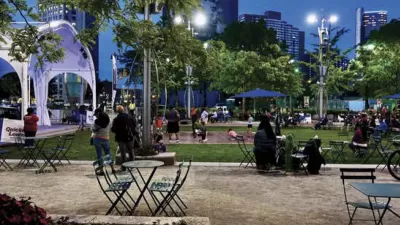Americans living in legacy cities face a unique set of challenges and opportunities in recovering from the COVID-19 pandemic. Several local, state, and federal support strategies could aid these cities in recouping losses.

America's legacy cities, think older industrial cities like Detroit, Cleveland, St. Louis, Pittsburgh, and Buffalo and Rochester, N.Y., are faced with unique and unprecedented challenges during the COVID-19 pandemic, says Lavea Brachman. With historical roots as key players in the industrial and manufacturing economies, legacy cities have experienced decades of high rates of unemployment with many residents facing chronic poverty and material insecurity.
"Putting these places on the road to recovery and prosperity is key to mitigating harmful regional imbalances in the U.S. economy, and their demographic legacies make them linchpins in the country’s efforts to achieve greater racial equity," writes Brachman. "Ensuring prosperity in these cities will not only yield economic benefits for our nation but also advance social progress."
Brachman's article goes on to lay out five reasons "why legacy cities could be hit harder than other places" as well as three unique advantages possessed by legacy cities during crises. According to Brachman, collaboration is a necessity for driving a racially equitable recovery in legacy cities. One key point: intentionally creating economic points of entry to capital investment for minority entrepreneurs and entrepreneurs of color. "Local innovation—along with state and federal policies and supports—and a promising new generation of local leaders can drive such a recovery."
FULL STORY: The perils and promise of America’s legacy cities in the pandemic era

Alabama: Trump Terminates Settlements for Black Communities Harmed By Raw Sewage
Trump deemed the landmark civil rights agreement “illegal DEI and environmental justice policy.”

Planetizen Federal Action Tracker
A weekly monitor of how Trump’s orders and actions are impacting planners and planning in America.

Why Should We Subsidize Public Transportation?
Many public transit agencies face financial stress due to rising costs, declining fare revenue, and declining subsidies. Transit advocates must provide a strong business case for increasing public transit funding.

Understanding Road Diets
An explainer from Momentum highlights the advantages of reducing vehicle lanes in favor of more bike, transit, and pedestrian infrastructure.

New California Law Regulates Warehouse Pollution
A new law tightens building and emissions regulations for large distribution warehouses to mitigate air pollution and traffic in surrounding communities.

Phoenix Announces Opening Date for Light Rail Extension
The South Central extension will connect South Phoenix to downtown and other major hubs starting on June 7.
Urban Design for Planners 1: Software Tools
This six-course series explores essential urban design concepts using open source software and equips planners with the tools they need to participate fully in the urban design process.
Planning for Universal Design
Learn the tools for implementing Universal Design in planning regulations.
Caltrans
Smith Gee Studio
Institute for Housing and Urban Development Studies (IHS)
City of Grandview
Harvard GSD Executive Education
Toledo-Lucas County Plan Commissions
Salt Lake City
NYU Wagner Graduate School of Public Service





























